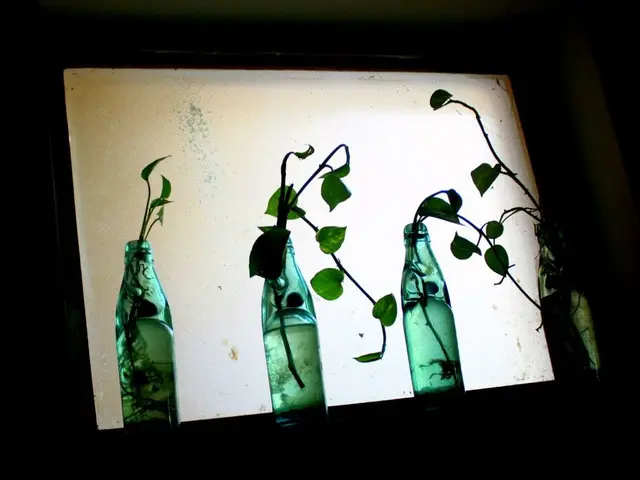Artists Slipping into Trance While Crafting: Insights into Brain Function during Creative Processes
It's an enchanting sight to witness an artist in deep concentration, seemingly lost to the world as they immerse themselves in their work. This state of mind, often described as a 'trance state' or 'being in the zone,' is a captivating phenomenon that has long intrigued observers. However, what exactly triggers these creative trances, and what does it reveal about the workings of the human brain?
Understanding the Creative Trance
To explore the nature of the trance state, let's first define it. This state is characterized by profound focus and a diminished awareness of the external environment, enabling the artist to fully delve into their inner world while momentarily disconnecting from their surroundings.
Key Characteristics
Artists in a trance state express intense concentration, loss of self-consciousness, distorted perceptions of time, and heightened creativity and problem-solving skills. The intriguing question then arises: which brain functions are being augmented during this state?
The Brain's Role in Creative Processes
The human brain is a complex organ composed of multiple regions that collaborate to manage myriad tasks. When it comes to creativity, several key areas play essential roles, including the prefrontal cortex, the default mode network, and the reward centers.
The Prefrontal Cortex
The prefrontal cortex serves as the brain's control center, responsible for decision-making, self-control, and complex cognitive processes. In a creative endeavor such as painting, the brain may down-regulate this area to minimize overthinking and stimulate spontaneous, imaginative thoughts.
The Default Mode Network
This network is active during rest periods when the brain engages in introspective thoughts, such as daydreaming or reflection. In a trance state during painting, this network might become more active, facilitating the free flow of ideas and imagery.
Reward Centers
The brain's reward centers connect to the release of dopamine, an essential neurotransmitter linked to motivation, pleasure, and reward. When artists enter a trance, the activation of these reward centers could contribute to the exhilarating and fulfilling feelings they often sensation.
Why Do Some Artists Enter Trance States?
While the reasons may vary amongst artists, there are several factors that might predispose certain creatives to enter such a deeply focused state more readily. Here we present a few:
Innate Talent or Training
Artists who spend substantial amounts of time honing their skills may find it easier to enter a trance-like state marked by smooth, flawless movements and unhindered focus.
Emotional Connection
A strong emotional bond with the work can make it simpler for artists to immerse themselves completely. This is especially true when the art is emotionally resonant with personal experiences or thematic themes.
Mindfulness and Meditation
Practices like mindfulness and meditation can help condition the brain to attain trance-like states, making it easier to maintain focus and get absorbed in the creative process when it's time to paint.
Implications for Brain Health
The intriguing question of why artists drop into trance states during the creative process doesn't only shed light on artistic production; it also opens up interesting possibilities for brain health and well-being. Here are potential benefits:
Stress Reduction
Entering a trance state is often accompanied by a reduction in stress and anxiety, as the artist becomes engrossed in their work and disengages from external concerns.
Enhanced Cognitive Function
Regularly engaging in activities requiring such deep focus might improve cognitive functions over time, including memory, attention, and problem-solving skills - all pivotal for a healthy, functioning brain.
Improved Emotional Well-being
By serving as a therapeutic outlet for emotions, painting can help individuals develop greater emotional well-being by fostering the ability to express themselves in ways that might be difficult through words alone.
Brain Supplements and Enhancing Creativity
Given the thriving interest in enhancing creativity, there has been a growing emphasis on brain supplements, also known as 'nootropics.' These dietary products are designed to bolster brain functions essential for creativity, including memory, focus, and mental clarity.
Ingredients in Brain Supplements
- Bacopa Monnieri: believed to improve memory and cognitive functions by facilitating synaptic communication.
- Rhodiola Rosea: stored in the brain for stress reduction and strengthened focus during taxing mental tasks.
- L-Theanine: an amino acid found in tea that fosters relaxation without drowsiness and improves attention span.
- Ginkgo Biloba: utilized traditionally to support memory and cognitive sharpness by increasing blood flow to the brain.
- Omega-3 Fatty Acids: deemed vital for brain health and connected to improved mood and cognitive performance.
Potential Benefits for Painters
Although further study is necessary to establish the precise effects, many artists incorporate various brain supplements in an effort to boost creativity. For painters, potential benefits may include:
- Enhanced focus and concentration, making it easier to reach and maintain a trance state while painting.
- Improved mood and decreased anxiety, promoting a more receptive creative mindset.
- Better memory retention of ideas and practices, contributing to an enriched creative process.
The Fascinating Intersection of Art and Science
The phenomenon of artists entering trance states during the creative process presents a thrilling intersection between art and science. Through understanding the underlying mental processes involved and potentially augmenting them with focused practices and mind-enhancing supplements, we open up avenues to unlock greater levels of creativity and insight, not only in art but in multiple realms of human endeavor.
As our awareness of the human brain evolves, we can expect to witness even more innovative strategies for harnessing the brain's power and pushing the boundaries of creativity.
- The trance state in artists, a profound focus where awareness of the external environment diminishes, allows them to delve deeply into their inner world during their work.
- Intense concentration, loss of self-consciousness, distorted perceptions of time, and heightened creativity are characteristics of artists in a trance state.
- To explore the trance state, we must first understand what it is; a state characterized by diminished awareness of the external environment, allowing artistic immersion and inner world exploration.
- The prefrontal cortex, responsible for complex cognitive processes such as decision-making, becomes down-regulated during a creative endeavor to stimulate spontaneous, imaginative thoughts.
- The default mode network, active during introspective thought, might become more active in a trance state during painting, facilitating a free flow of ideas and imagery.
- The brain's reward centers, connected to motivation, pleasure, and reward, could contribute to exhilarating and fulfilling feelings during artistic trances.
- Artists who spend substantial time honing their skills may find it easier to enter a trance-like state characterized by smooth, flawless movements and unhindered focus.
- A strong emotional bond with the work can make it simpler for artists to immerse themselves completely in a trance state, as it is resonant with personal experiences or thematic themes.
- Mindfulness and meditation can help condition the brain to attain trance-like states, making it easier to maintain focus and become absorbed in the creative process.
- Stress reduction, improved cognitive functions, and enhanced emotional well-being are potential benefits of entering a trance state during the creative process.
- Nootropics, or brain supplements, aim to bolster brain functions essential for creativity, including memory, focus, and mental clarity, which may help artists enhance their creative process.







